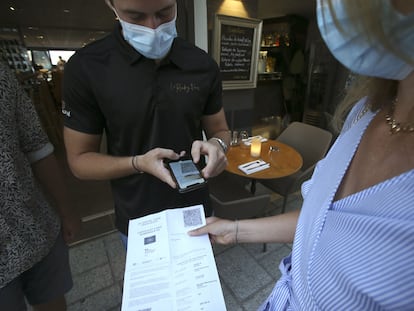2020: The year the coronavirus pandemic turned Barcelona upside down
Newly released statistics reveal the heavy toll the health crisis has had on all aspects of life in Catalan city, from fatality rates and unemployment to culture and crime


The coronavirus pandemic broke all statistical records in the city of Barcelona, in Spain’s northeastern region of Catalonia. That’s according to newly released data compiled in the 2021 Statistical Yearbook, which is based on figures from 2020, when the health crisis first hit. This document, published by Barcelona’s Municipal Data Office (OMD), shows the extent to which all aspects of life have been affected by the pandemic.
“It will be a reference year for future generations and go down in history due to the impact of Covid,” said Maria Jesús Calvo, the head of the OMD’S statistics and data dissemination office. According to Calvo, the yearbook – which has been going since 1902 – “captures in figures” the dramatic impact of the pandemic. Not since the last century, with the 1918 flu and Spanish Civil War (1936-1939), has the city of Barcelona been upturned to such a degree, she said.
The 450-page document, which includes 425 graphs, is separated into 20 chapters that analyze statistical changes in several areas such as health, economy, the environment and demography.
“As we became familiar with words such as PCR, confinement, state of alarm, curfew and perimetral lockdown [...] the data reflects how deaths shot up, unemployment rose, consumption dropped, airports became paralyzed and pollution fell,” Barcelona City Hall said in a press release.
One of the most striking points is the rise in fatalities due to the coronavirus. According to the yearbook, 19,000 deaths were recorded in Barcelona in 2020, 31% more than the previous year. Of this figure, 4,300 were due to Covid-19. The city also registered a slight fall in birth rates – as earlier revealed by the padrón, or municipal roll, from January 1, 2020. Data from 2021 will reveal whether this downward trend has continued or whether births have jumped back up. According to the document, the migratory balance for Barcelona was negative, meaning more people left the city than entered it in 2020.
With respect to health, 78,412 coronavirus cases were recorded in Barcelona, of which nearly 54% were among women. The document also shows how differences in income were reflected in contagion rates, with areas with lower incomes recording higher incidences of the coronavirus. The pandemic’s impact on the public healthcare system can also be seen in the data: in 2020, there were more than 10 million medical consultations, including both in-person visits and phone check-ups.

The economic fallout of the pandemic saw the number of unemployed in Barcelona rise to 93,842, up 36% from December 2019. Lower-income areas were hit hardest by the rise in unemployment, according to the report. Meanwhile, the number of contracts signed in 2020 fell 54%. The gross domestic product (GDP) of Barcelona also fell by 11.6%, breaking the city’s years-long upward trend. After remaining stable for two years, annual household spending fell in 2020 from €35,000 to €30,000, a drop of 14%. As a result of the economic crisis, more people were in need of aid, with social services providing support to a record-high 88,500 residents. Most of this help was provided in the city’s lowest-income areas.
The Catalan city’s tourism sector was also hit hard by the pandemic, with the number of visitors dropping 77%. Trips on public transportation fell by 47%, while the city’s network of bicycle lanes expanded. In education, the number of students confined during the third coronarius wave, in the first quarter of the 2020-2021 school year, reached 18,000.
With respect to culture, the impact of the pandemic was equally significant: library visits dropped 63%, physical book loans fell by half (virtual loans nearly quadrupled), visitors to museums plummeted 76% and cinema-goers dropped 74%. In the performing arts, activity was cut by half, while the three main auditoriums – Barcelona’s opera house, the Gran Teatre del Liceu, Auditori de Barcelona and Palau de la Música concert hall – received 82% fewer spectators than in 2019.
As public activity fell, so too did crime. According to the document, the Catalan police force, the Mossos d’Esquadra, reported 42% fewer cases of criminal acts, with petty theft and violent robberies dropping 42% and 37%, respectively. The courts were also affected by the pandemic: the number of evictions fell by half, in large part due to the moratorium introduced by the Spanish government. Meanwhile, firefighters carried out 11% fewer interventions, but doubled their operations with institutions.
Incidence rate continues to rise
The national incidence rate of the coronavirus has risen to 112 cases per 100,000 inhabitants, according to the latest Health Ministry report, released Friday as no data is published on the weekend. This is 7.6 points higher than the figure reported on Thursday.
In total, Spain has detected 5,080,666 cases since the beginning of the pandemic, while the official death toll stands at 87,810.
Pressure on hospitals is also rising slightly: 2,393 hospital admissions were recorded on Friday, 90 more than on Sunday. This equates to an occupancy rate of 1.93% of all hospital beds. In intensive care units (ICUs), this figure is 5.08%, with 458 Covid-19 patients in the critical units.
Tu suscripción se está usando en otro dispositivo
¿Quieres añadir otro usuario a tu suscripción?
Si continúas leyendo en este dispositivo, no se podrá leer en el otro.
FlechaTu suscripción se está usando en otro dispositivo y solo puedes acceder a EL PAÍS desde un dispositivo a la vez.
Si quieres compartir tu cuenta, cambia tu suscripción a la modalidad Premium, así podrás añadir otro usuario. Cada uno accederá con su propia cuenta de email, lo que os permitirá personalizar vuestra experiencia en EL PAÍS.
¿Tienes una suscripción de empresa? Accede aquí para contratar más cuentas.
En el caso de no saber quién está usando tu cuenta, te recomendamos cambiar tu contraseña aquí.
Si decides continuar compartiendo tu cuenta, este mensaje se mostrará en tu dispositivo y en el de la otra persona que está usando tu cuenta de forma indefinida, afectando a tu experiencia de lectura. Puedes consultar aquí los términos y condiciones de la suscripción digital.
More information
Últimas noticias
Most viewed
- Reinhard Genzel, Nobel laureate in physics: ‘One-minute videos will never give you the truth’
- Oona Chaplin: ‘I told James Cameron that I was living in a treehouse and starting a permaculture project with a friend’
- Pablo Escobar’s hippos: A serious environmental problem, 40 years on
- Charles Dubouloz, mountaineering star, retires at 36 with a farewell tour inspired by Walter Bonatti
- Why we lost the habit of sleeping in two segments and how that changed our sense of time










































